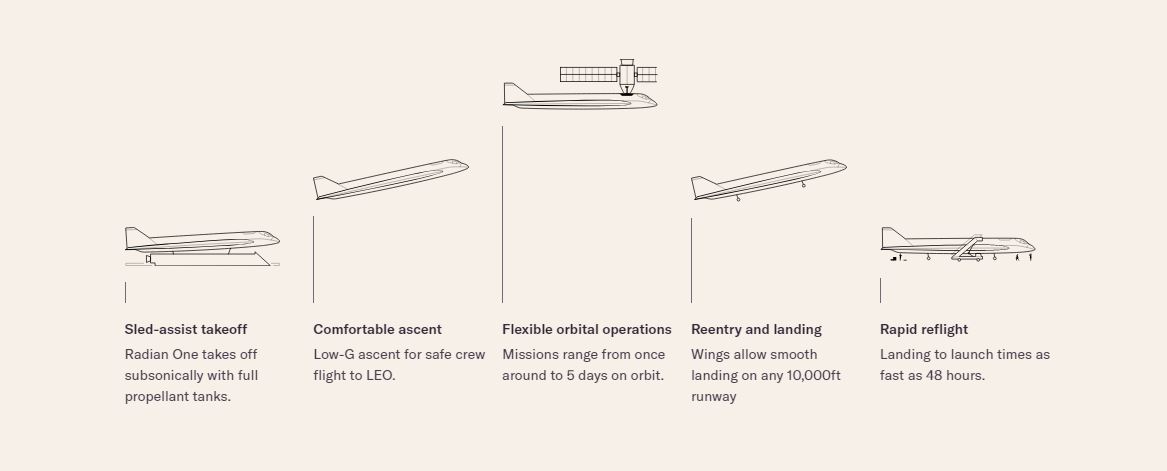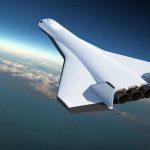Space tech startup Radian Aerospace emerges from stealth with $27.5M in funding to develop a fully-reusable spaceplane to carry cargo and crew to low Earth orbit

Rocket reusability, the concept first pioneered by Elon Musk’s company SpaceX, has helped to drive down the cost of reaching space. Now, one startup is trying to build the world’s first truly reusable orbital aerospace vehicle to carry cargo and crew to low Earth orbit.
Enter Radian Aerospace (Radian), a Renton Washington space tech startup that’s disrupting the aerospace industry with the next-generation aerospace vehicle that is the world’s first fully reusable horizontal takeoff and landing, single-stage to orbit spaceplane, delivering people and light cargo to low earth orbit (LEO) and multiple terrestrial destinations with aircraft-like operations.
Today, Radian announced it has emerged from stealth with $27.5 million in seed funding to advance the development of its Radian One, the world’s first fully functional horizontal takeoff and landing, single-stage to orbit vehicle. Radian’s system will be capable of a wide range of space operations including the delivery of people and light cargo to low earth orbit (LEO) with aircraft-like operations.
The recent round was led by Fine Structure Ventures, a venture capital fund affiliated with FMR LLC, the parent company of Fidelity Investments, with additional investment from EXOR, The Venture Collective, Helios Capital, SpaceFund, Gaingels, The Private Shares Fund, Explorer 1 Fund, Type One Ventures as well as others.
Founded in 2016 by Livingston Holder, Radian has operated in stealth mode focusing on the design and initial development of a revolutionary aerospace vehicle that will fill the efficiency and capability gaps that exist with traditional vertical rockets.
“To date, a low-cost space transport solution has been lacking that can get humans and cargo to and from space at a highly responsive rate,” said Brett Rome, Venture Partner at Fine Structure Ventures. “Radian is well-positioned to fill that gap with disruptive technology that helps enable the emerging space economy. We are confident in the experienced team at Radian, and thrilled to be supporting its mission as Radian works to revolutionize the future of space access.”
Radian is building the first of a new generation of the launch vehicle with transformational capability and a wide range of applications. The ability to fly to space, perform a mission, return, refuel, and fly again almost immediately enables in-space and terrestrial missions that are simply not possible with traditional vehicles. Radian is leveraging existing enabling technologies with high technology readiness levels and integrating them in ways never done before.
“Wings offer capabilities and mission types that are simply not possible with traditional vertical takeoff right circular cylinder rockets,” said Livingston Holder, Radian’s co-founder, CTO and former head of the Future Space Transportation and X-33 program at Boeing. “What we are doing is hard, but it’s no longer impossible thanks to significant advancements in materials science, miniaturization, and manufacturing technologies.”
Radian’s new approach is expected to uncork existing aerospace markets and create entirely new ones.
“We believe that widespread access to space means limitless opportunities for humankind,” said Richard Humphrey, CEO and co-founder of Radian. “Over time, we intend to make space travel nearly as simple and convenient as airliner travel. We are not focused on tourism, we are dedicated to missions that make life better on our own planet, like research, in-space manufacturing, and terrestrial observation, as well as critical new missions like rapid global delivery right here on Earth.”
Radian will focus on mission types that align with its unique capabilities, many of which can only be done because of its winged configuration. The company already has launch service agreements with commercial space stations, in-space manufacturers, satellite, and cargo companies, as well as agreements with the U.S. government and selected foreign governments.
“Radian is leveraging a unique combination of technologies with an optimized business model to unlock what I like to call ‘the potential of space,’ serving existing aerospace markets and catalytically enabling new ones,” said Doug Greenlaw, a former chief executive of Lockheed Martin and one of Radian’s investors and strategic advisors. “We’re talking about materially enabling an industry that’s expected to grow to $1.4 trillion in less than a decade and Radian is doing what’s known as the ‘Holy Grail’ of accessing space with full reusability and responsiveness to provide customers unmatched cost-effectiveness and flexibility.”
The addressable commercial market opportunity for Radian’s disruptive launch vehicle is estimated to be $200 billion. Radian’s goal is to steadily mature its core technologies; eventually permitting aircraft-like flight cadence at lower per mission cost.
“On-demand space operations is a growing economy, and I believe Radian’s technology can deliver on the right-sized, high-cadence operations that the market opportunity is showing,” said Dylan Taylor, Chairman and CEO of Voyager Space and an early personal investor in Radian. “I am confident in the team working at Radian and look forward to cheering them along in this historical endeavor.”

Radian One Flight Profile




